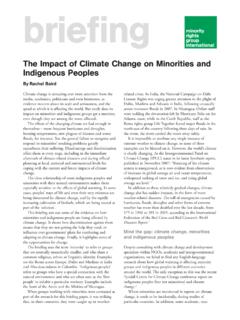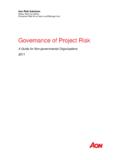Transcription of KENYA GOOD GOVERNANCE PROJECT (KGGP)
1 KENYA good GOVERNANCE PROJECT ( kggp ) END OF PROJECT EVALUATION Kitakaya Loisa 7/24/2013 Nairobi, KENYA 2 TABLE OF CONTENTS Acronyms and Words with Unfamiliar PROJECT INFORMATION EXECUTIVE I. 1. 1. Description of the 1. 2. PROJECT Operating 1. 3. Purpose and Scope of the II. EVALUATION Literature Data Independence of the Challenges during the III. EVALUATION PROJECT PROJECT Minority Issues and External Factors that Aided the Challenges Encountered during IV. V. LESSONS VI. VII. 1. List of Persons 2. Field 3. List of Documents source of Information 4. Terms of Reference of the 3 Acronyms and Words with Unfamiliar Meaning ACHPR African Commission on Human and People s Rights CfP Call for Proposals CIC Constitution Implementation Commission EWC Endorois Welfare Council FGD Focus Group Discussion IEBC Independent Electoral Boundaries Commission IIBRC Interim Independent Boundaries Review Commission kggp The KENYA good GOVERNANCE PROJECT KMCC Kenyan Minority Communities Council KNCHR KENYA National Commission on Human Rights MICs Minority and Indigenous Communities MIPs NSAs Minority and Indigenous People s Non State Actors MRG Minority Rights Group International OECD Organisation for Economic Cooperation and Development OPDP Ogiek People s
2 Development Programme The PROJECT The KENYA good GOVERNANCE PROJECT ( kggp ) WIFIP Women in the Fishing Industry Project4 PROJECT INFORMATION SUMMARY Reference of the Call for Proposals EUROPEAID/128187/L/ACT/KE Title of the Call for Proposals Non State Actors in Development, Action in partner countries, KENYA Title of the action: Promoting good GOVERNANCE and Ensuring the Inclusion of Minorities and Indigenous Peoples in KENYA Number and title of lot Lot 2, GOVERNANCE Location(s) of the action: Country: KENYA nationwide with a particular focus on Rift Valley and Nyanza Provinces Name of the applicant Minority Rights Group International (MRG) Nationality of the applicant British EuropeAid ID GB 2007 DQR 2711290645 Legal status Non Profit Making, registered under UK Charity Law Partner 1 Endorois Welfare Council (EWC), non profit making, KENYA Partner 2 Indigenous Fisher Peoples Network (IFNP), non profit making, KENYA Partner 3 Ogiek s People Development Programme (OPDP), non profit making, KENYA Budget EUR 599, 5 EXECUTIVE SUMMARY The KENYA good GOVERNANCE PROJECT ( kggp ) was a partnership PROJECT between Minority Rights Group International and three Kenyan minority and indigenous communities organisations Ogiek People s Development Programme (OPDP), Endorois Welfare Council (EWC)
3 And the Women in the Fishing Industry PROJECT (WIFIP), funded by the European Union. The PROJECT supported the Kenyan partners in capacity building to enable them push for political and constitutional changes in favour of minority communities in KENYA . This evaluation assesses the impact of the PROJECT on the target communities and organisations by investigating whether activities were effective in contributing to the outputs and whether the projects outputs made the best fit that contributes to the PROJECT outcomes. In addition, the evaluation assessed the quality and level of completion of activities by the time the PROJECT ended and whether the PROJECT was efficient by comparing the results with the investments made. The evaluation employed a participatory approach where in addition to literature review, perspectives of MRG staff and those of staff from partners implementing the PROJECT were sought through discussions, meetings and consultations.
4 Similarly, we interviewed community members and leaders in the PROJECT areas affording them the opportunity to discuss and interrogate the performance of the PROJECT . Other organisations that had interacted with the PROJECT were interviewed. The kggp was premised on capacity gaps within minority and indigenous civil society organisations (CSOs), limited collaboration between minority and indigenous representatives and the KENYA state actors, and limited support from the Kenyan society and the Kenyan media for the struggle faced by minority communities. Accordingly, kggp worked to facilitate linkages between MIPs NSAs to work with CSOs, state agencies, and the media in KENYA . Specifically, the PROJECT worked with community leaders from targeted minority and indigenous communities, members of the minority and indigenous communities, Kenyan CSOs, MPs, Government, district authorities, academy, media, UN and International Organisations.
5 kggp activities covered four broad areas of capacity building, research and publications, advocacy, public and media work. Capacity building activities comprised of training workshops for minority and indigenous communities (MICs) on media skills, human rights, advocacy, and techniques of engaging national actors. Although not part of the initial plan, implementing partners received training in financial reporting, monitoring and evaluation and fundraising skills. In addition to these, EWC received training in strategic planning. Research and publication activities comprised of reports on the state of KENYA s indigenous and minority people and advocacy briefs. Activities under advocacy included community specific advocacy campaigns, a national advocacy campaign on access to justice, election 6 work, and an annual parliamentary event aimed at seeking the support of members of the national parliament.
6 Publication of positive stories about minorities in KENYA was successful with a number of media houses highlighting minority issues thereby raising the level of awareness of the public. Activities under kggp were implemented one at a time. Before funds could be disbursed for an activity, a partner would prepare a concept for such an activity with related sub activities. The approach allowed partners the space to react to emerging issues and make modifications according to circumstances while remaining within the scope of the PROJECT proposal. The media campaign and training events at the community level were the most effective activities. These activities brought MIPs NSAs in KENYA into contact with national processes and state actors and into the national CSOs landscape, a key objective of the PROJECT .
7 The activities prior to and during the kggp have opened a new chapter in the lives of MICs in KENYA . MRG s support to the Endorois community quest to reclaim lost land achieved positive results with immense impact on MICs and their pursuit of their rights. MRG supported the process through provision of legal services when the community filed a case with the African Commission on Human and People s Rights (ACHPR). The ACHRP ruling on the Endorois Community Land Complaint, which recommended that the community be given back their land, has aroused interest among scholars who view it as a landmark and progressive judgement. There is also renewed interest among many MICs to map out their land. Several MICs in KENYA including the Pokot, Boni, Turkana, etc will be supported by the Ford Foundation to map out their lands.
8 Two other minority communities in Baringo County, the Lempus and the Ilchamus, are each exploring ways of reclaiming land that was taken from them or compensation for resources exploited on their land. The complementary relationship between the different kggp activities research and publications, media campaign, and advocacy was not utilised fully to make them optimally effective. Further, were activities conducted with long time intervals, which rendered some less effective due to loss of momentum among target communities. Some of the valuable lessons from the PROJECT are listed below: Organisations are dynamic entities that need regular monitoring and up to date assessment to gauge their capacities before collaborating with them. Above all, proof of sound GOVERNANCE systems on the part of potential partners is paramount.
9 For capacity building to be integrated into an organisation s culture and new skills institutionalised, a formal and systematic organisational development framework with clear targets is necessary. 7 An effective way to build capacity it turned out was exposing partners to the rigor of developing concept notes before they received funding to implement those activities. The requirement of concept notes before disbursement served as a motivation. The risk of a PROJECT being affected adversely by the withdrawal of one or more partners is reduced drastically where there is more than one partner engaged in implementation. When non state actors capitalise on national processes with government support the effectiveness of their activities is enhanced.
10 The civic education and constitution writing processes in KENYA gave impetus to activities under kggp . In view of the findings, we recommend the following: i.) As far as unrestricted budget limitations allow, MRG should review its partner assessment tool to include criteria such as track record, respect/standing within sector, wide ranging and useful sectors, willingness to share, sound management, GOVERNANCE structures, audited financial accounts (done by reputable firms) and strict fiduciary measures. ii.) Part of the partner selection criteria should be recommendations on what actions an organisation should take to enhance its capacity before partnership is formalised with MRG. iii.) MRG and partner should form strategic alliances with enduring national institutions such as the National Gender and Equality Commission and the KENYA National Commission on Human Rights to reduce costs in its programming.










